Ed. Note: This was Sawbina’s winning entry at Queen’s Prize 2016

Ed. Note: This was Sawbina’s winning entry at Queen’s Prize 2016
Gleaned from Facebook:
THL Eynon Llangenydd announces:
My pictures of most of the QPT projects and some of the artisans have been uploaded to a Flickr album. I might pare the numbers down a bit and post to a Facebook album later. I didn’t get everyone’s projects and some shots were a bit awkward to avoid disturbing judging
by Lady Elaisse de Garrigues
War was calling. Our enemies were massing far to the east, so our mighty Konung, Duncan Bruce of Logan, mustered our warriors for the long march to that faraway kingdom. Many battles were fought in the great Pennsic War, but this is the tale of one particular battle—a battle for a bridge.
The army of Artemisia had twice our number, nay, tenfold at least, and the only thing holding them back was the churning water of the rain-swollen river. That endless horde, eager to storm across the bridge and slaughter everything in its path, was a chilling sight, but the Calontiri knew no fear. Logan strode to the bridge and hurled a spear toward those shining Artemisian helms with a bellow of “Odin owns you all!”
With a shield-shattering roar, the Calon host charged onto the bridge. The Artemisians could not withstand the Calontiri onslaught. Slowly at first, then with greater speed, the Artemisians fell back as our warriors fought their way across the bridge.
“Arrow!” someone shouted. First one dark missile, then another, arced through the sky then landed harmlessly on upheld Calontiri shields. Logan laughed. “You’ll need more than pointy sticks to send me to Valhalla!” he roared with a deadly swing of his war hammer.
The Artemisians fell back, and back, until the Calon host had nearly reached the far side of the river. “Arrow!” someone called again. This time the sky darkened and the air hissed with dozens of missiles speeding toward the Calontiri. “Shields!” Logan bellowed. Our warriors hunkered beneath as the deadly rain beat against the wood and iron of the Calon shields. That, my friends, is the moment Artemisia charged.
Taken by surprise, the Calontiri fell, one after another joining their dying comrades in the growing river of Calon blood. The survivors retreated, defeat bitter on their tongues. As brave as our warriors are, they might have slunk home in shame, but Logan stood firm. “By Tyr, we will not be beaten!” he shouted. Drawing courage from their Konung’s strength, the Calon host surged forward once again.
As before, the Artemisians staggered under our swords and we forced our way across the bridge. And as before, a flock of fletched missiles darkened the sky. This time we were ready, though. This time, when the Artemisians charged, our warriors met them with deadly steel. This time, the bridge ran slick with Artemisian blood.
And though many Calon warriors found their way to Valhalla, thanks to Logan’s courage, strength and will, no Artemisian crossed that bridge that day.
Sir Cai arranged for his company to allow the SCA to hold a full-on demo at his annual company picnic. Kalmar Industries in Ottawa, KS hosted SCA folk from multiple nearby groups, including the Shire of Carlsby, the Shire of Cum an Iolair, the Shire of Crescent Moon, the Canton of Aston Tor and the Barony of Forgotten Sea. Visitors from distant groups, including the Barony of Vatavia and the Shire of Golden Seas even joined in the fun. This author is certain she has left out some groups, as well. Apologies for that. There were so many people, the demo was certainly the size of a decent event!
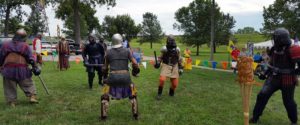
Look at all that Meanest Mother Melee fighting!
We had enough people for tourney fighting, cut-and-thrust and archery events side-by-side, multiple-fighter melees, several meanest-mother melees and even some old style Holmgang melees. This author heard laughing and great fun coming from the list field throughout the day. Epic deaths were seen. Even Ottawa residents came to the park, set up their lawn chairs and watched the sport throughout the day, enjoying the unusually mild August weather.
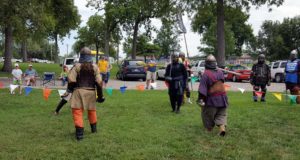
Ottawa’s newest spectator sport
The SCA personnel put on a fine showing of our best artisanry, too. We fully encircled the list fields with pavilions full of our best displays, from scribal arts through a fully functional forge thanks to Baron Lothar! Several people combined their talents to show how wool moves from sheep to fully woven fabric, including spindles, a spinning wheel, and two kinds of looms. Mistress Dorcas provided an entire pavilion of heraldic goodies and information, too.

Amazing fiber arts demo – sheep to shawl!
An all-day chainmail demo by HL Thomas the Black, armoring, sewing, displays of the Baronial coronets, finished garb hanging in the pavilions, and lots of people willing to talk about the SCA and our period of history provided a well-rounded, educational opportunity for the Kalmar employees, their families and others who visited. Many friends and family members of the SCA folks came by to see us, too!
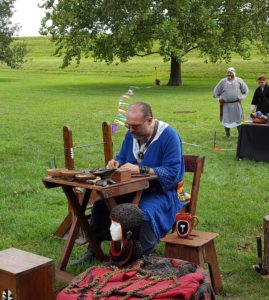
H.L. Thomas the Black and his chain mail demo
Sir Cai graciously printed outstanding informational brochures and amazing laminated SCA bookmarks for us to give to visitors during our recruitment efforts. These proved very popular with the younger set, who also enjoyed the hands-on nature of most of the demo items. Being able to touch real, hand-woven fabric, chainmail, armored fighters and heraldic banners caused more than one young mouth to gape in amazement as they saw storybooks come alive before their eyes. Lady Maegwynn provided heraldic announcements before the fighting, including explanations of the SCA – who we are, what we do, and why the visitors should come around and check out the demos.
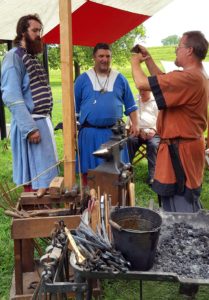
Baron Lothar explaining how he is forging his Holder Down Thing
As a reward for our demo, the Kalmar folks provided the SCA demo-ers with a luscious BBQ lunch of pork, turkey, beef and all the sides. Bounce-houses and a bounce-obstacle course for the kids were available, although us adults were sadly not allowed. We debated the wisdom of obtaining ones rated for grownups for the next Tor Party at Lilies.
It was a beautiful day of temperate weather, gentle breezes, great fun fighting and some of the best fun many of us had in a long time. We wish the rest of you had been able to join us! Enjoy the photos – I’ve linked them to my Flickr page, because I took so many. These are just a few teasers.
Link to Photos: https://www.flickr.com/photos/7579381@N02/albums/72157672317838635
In joyous fealty to the Crown and People of Calontir, I remain your loyal servant and Scribe-
Takashoka Spaekona Aidan Cocrinn, OL
Another great opportunity at Pennsic! This one is for the A&S War Point, and has been offered to Calontir by TRMs Ealdormere, Nigel and Adrielle. The entrant would need to be “unwreathed” (not a Laurel), and other information is below. Please contact ME ASAP if you are interested. We want to let Them know by Friday at noon.
“Basics of the A&S War Point
When – Thursday of War Week, in the Great Hall. 9-3pm
Entrants are encouraged to arrive around 8-ish to set up- each entrant will pick a number out of a hat, which will correspond to a table space. (Approximately 3-4 feet). Artisans are encouraged to stand by their displays to interact with visitors but it is not mandatory.
Judging is by “populace choice”- any person with an A&S award given to them from a Crown (AoA, GoA, and Peerage levels) will receive 3 pony beads to vote with. Judging takes place from 9-3. From 3-4pm the votes are tallyed, and results are announced at 4.
Documentation is not required, but, because at least some of the voters are laurels, it is probably wise to provide it. The works of a specific artisan are judged as a body of work- so you could bring one mas terpiece, or several smaller pieces. Last years winners spanned the gamut- we had one single, extraordinary piece as the top winner on one side, and multiple part bodies of work win for the other side.
The Great Hall will be overseen by volunteers during the competition- A&S Officers and solicited help from several kingdoms, but there’s always room for more volunteers. 🙂”
We would love to be able to show off one of Our artisans in this way!
Ylva drottning
By Aidan Cocrinn, OL © Holly Cochran July 2016
One of the many highlights of Summer Coronation, held July 9, 2016 in the Barony of Coeur d’Ennui, was the investiture of Matsunaga and Elena as Count and Countess. In commemoration of their Reign, both received their County coronets from the hands of their Heirs, Logan and Ylva. In addition, scrolls with the words of the new Crown were presented. Below are the texts of those scrolls, along with photos. Truly, both awards were wonders to behold.
Aidan Cocrinn, OL
Royal Scribe for Matsunaga and Elena, with gratitude and thanks for that great honor
Countess Scroll for Her Excellency Elena text was crafted by Mistress Ishmala bint Yuhannah. The scroll itself was created by Baroness Neathery of Safita.
Right trusty and well-beloved we greet you well. It hath pleased the goodness of Almighty God of his infinite mercy and grace to deliver unto this glorious kingdom this great lady called Elena Moreno del Mar. By the prowess and might of Matsunaga Kagetora she was made his consort and brought great joy and comfort to all the good and loving subjects of the realm. This singular rose has mighty thorns and shielded her people on campaign when the winds turned tempest, she gave wise council to all, and kept her head at all times.
It is our great pleasure and inward desire that you continue to give comfort and consolation to our people. We therefore by this letter advise you that you are made a countess of our realm and are given lands equal to our esteem for you. We bequeath you the Wardenry of Royal Forests near the Crystal Mines where you may build a home with no less than four chimneys and may hunt and hawk at your pleasure.
We undoubtedly desire that you continue to give laud and praise to all subjects of our heart regardless of rank, and pray for the good health, prosperity, and continual preservation of our realm.
Given under our signet in the Barony of Coeur d’Ennui this 9th day of July, in the 50th year of our Society.
The County scroll for Matsunaga was created by Viscount Master Christopher Reuben Montoya, formerly of Atenvelt, now residing in Grimfells. The text was crafted by Master Andrixos.
Cease Kamikaze
Blow no more, heavenly wind
Upon King, upon Kingdom
Rising Sun has brought storm’s end
In calm, all recall tempest
Reclaim lost pillow
Traveler’s cushion far wandered
From home of the dawn
To land entranced by sunsets
Path of pillow was king’s road
Brought from the Nippon
To Heartland and to Shogun
Hail, Matsunaga.
Wind-driver and wind-driven
Strong gale blew through Calontir
Eight corners he saw
As Falcon soaring above
Lifted by wind’s strength
Soft breeze brought he to the land
Spring’s zephyrs caused winter’s rout
He subdued blizzard
And sought stronger storm to test
Led samurai south
To war field well windswept
Foes all dispersed by his gust
Gods keep man humble
After victor’s council held
Divine bellows turned
Brought rain like forge’s fire
Fortress strong sacked by wind-flood
Among folk he strode
Seeing aid brought to needy
Raising homes sunk low
Sheltering people from fear
Here he did gust as a king
Like a willow tree
Falcon tribe withstood the storm
Plans for new fortress
Stories of maelstroms survived
Realm prepared for a new calm
O Matsunaga
Storm bringer in war’s fury
For kingship, well worn.
Headband bright like Rising Sun
And high honors earned granted.
By these words did Duncan Rex and Ylva Regina recognize Matsunaga Kagetori as a Count, and endow him with such rights and obligations accompanying such elevation, including a coronet of gold embattled. Done on the ninth day of July in the Land of the Ring of Red Boars, in the fifty first year of the Society

Scroll by Viscount Master Christopher Reuben Montoya, words by Master Andrixos Seljukroctonis
From the artist: It is written in the Japanese form of 10 Tankas; A 57577 syllable arrangement. The scroll itself is done with Sumi-e (black ink brush, and the painting depicts Fujin, the Japanese wind god, and Matsunaga fighting while His Excellency is protecting beloved Calontir behind him. The scroll text is in English, scribed in Japanese letter characters. It is written in the “kanji” form (vertical columns/right to left) over Suminagashi (floating ink or marbled) paper. The Silk horizontal scroll frame is by Blue Heron Arts and mounting was done by the scribe.
Next from this author: H.L. Vels created an amazing addition to the Royal Scribe’s office, which was gifted to TRM and the RS Office at Coronation. Read ALL the details and see the amazing close-up photos in the next article.

Royal Scribe Box by HL Vels- Front Panel. Just a teaser!
CORRECTION: This post has been corrected to reflect Mistress Ishmala bint Yuhannah as the author of the scroll text for Countess Elena. Also, Viscount Master Christopher originally hails from Atenveldt. The author deeply regrets these errors.
Save
Summer Coronation 2016, celebrating the crowning of Krununger Logan and Drotting Ylva was held in the Barony of Coeur d’Ennui on July 9. 2016. The event drew a spectacular crowd from across the Kingdom, and even visitors from outside the Falcon Borders.
Before Coronation Court, I had the distinct honor of presenting TRM Matsunaga and Elena with a gift from Their Scribes and Text Writers, hand-made by Lord SeanAngus Macduinnchinn (mka Christopher Brown) from the Barony of V’Tavia. He had driven all Friday evening and Saturday in the pre-dawn hours to deliver these treasures to me before opening Court.
Each preprint scroll included in the books had the name of the text writer, the calligrapher and the illuminator noted on the scroll. The inside covers are pieces of the Royal Pavilion which gave its life at Gulf Wars. His Grace Ostwald provided the fabric to me in secret some months prior to his passing, not knowing the ultimate purpose – only that it was to go for a stepping-down gift for Matsu and Elena.
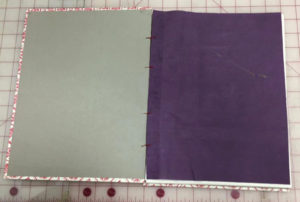
Inside cover of each book is crafted from a piece of the Royal Pavilion, which gave its life at Gulf Wars, 2016
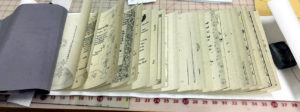
Matsunaga’s “Dragon Scale” style book, unrolled, displaying the preprints of the Reign.
These books, then, contain not only the gifts of the Scribes and the Text Writers, as well as the gifts of the very talented Ld. SeanAngus, but a piece of the very heart of Calontir’s Living room and a memory of Duke Sir Ostwald, as well. We hope Their Excellencies will smile when they glance through the memories of Their Reign.
In Service-
Royal Scribe to Matsunaga and Elena
Aidan Cocrinn, OL
Lord SeanAngus provided the following information regarding the books, his process and the documentation he used to produce them. He also provided the photos included in this article. These are the words of Ld. SeanAngus Macduinnchinn:
HRM Matsunaga received a scroll of pre-printed scrolls, which when unfurled and hung from a dowel, which appears as the scales of an Asian dragon. The name of the scroll format is “Dragon Scale” scroll. This binding is sometimes called xuanfeng zhuang (“fluttering in the wind” or whirlwind binding). While it is not the traditional, single scroll Kakejiku, we see the lineage in its transferal from the Buddhist monks of the mainland to Japan, as was the codex bindings of the teachings of Buddha.
From these roots in China came the transition of the scroll to the codex, the “Dragon scale scroll” as fleeting in history as the cherry blossoms in spring. Few Extant examples exist in China. Examples from the Tang Dynasty (618-907 AD) and sometimes the rare dragon bound book, can be found in the National Palace Museum.

Matsunaga’s Dragon Scale Book – Rolled

Example of Dragon Scale Book – Semi-unfurled
HRM Elena received a Coptic binding of single sheets of pre-printed scrolls. This binding is found throughout the Mediterranean area including mainland Spain, largely due to the Arabic influence there from around 700-1500. The Coptic binding is particularly suited to single sheet bindings, having been used in the earliest known “true” codices, for both legal and religious preservation of writing.
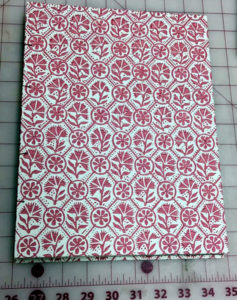
Cover of Countess Elena’s Book depicting Her Heraldic Device Elements

Spine of Her Excellency’s Book, showing the Coptic style of bookbinding
Each binding contains a piece of the Purple Pavilion destroyed in the 2016 Gulf War storms.
These bindings were produced as a keepsake of Their Reign, and may serve as a reminder of the inspiration each member of the SCA provides to one another.
Save
Save
Posted with permission from https://kaloethina.wordpress.com/
Original post appeared March 2, 2016.
I’ve recently received some requests on how to paint heraldic banners for use outside. I really enjoy painting heraldry on canvas, as I feel it looks more period. (I love silk banners – really, I do, however, silk in period was a luxury, and reserved more for clothes than for something would have whipped around in the wind or thrown on the ground or any number things that just shouldn’t happen to good silk. I might be Byzantine, but I digress.)
Heraldic banners – often a determinant of friend or foe across the field of battle, were also a form of decoration, whether by hanging from the rafters of a great hall or by adding pizzazz to a processional. Additionally, painting canvas in a trompe l’oeil effect was used to great degree during the Field of Cloth of Gold, where the elaborate accommodations (in this case, canvas pavilions), were decorated in and out with lush painting, though these were less heraldically inspired in nature, though it is noted within a folio of designs for the Field of Cloth of Gold, that some pavilions are painted with gold fleur-de-lis on a blue background, an excellent use of heraldry for France.1
The process in period consisted of a ground or gesso layer, followed by the painted layer (usually oils in later SCA-period), similar to other painting preparation processes for wood panels within the Italian and Northern Renaissance.2 Painted fabric, usually linen, was abundantly mentioned, famously in Shakespeare3, – items from clothing to wall-hangings to religious paraments, and as noted withing the diary of Prior More (p84), the cost of painting and sewing cloth for banners.
Lynnyn cloth for ye lyttle hawle at Batnall s d
Item for lynyn cloth for bordurs to ye lyttul parlour
withyn the lyttul hall and ye parlour at Batnall ………………….. 12 0
Item for the peyntyng of ye same to Thomas Peynter …………. 3 4
Item for sowyng of ye honggyng sayes in qe seyd parlours &
for thryd ………………………………………………………… 4
Peyntyng of bordurs. Item payd to Thomas Peynter for
Peynting Ye bordurs in ye lyttal parlour withyn ye lyttul hawle .. 5 4
Item for lynnen for bordurs to peynt for the hall at Grymley …… 2 5
Item for the peyntyng of the same to Thomas Peynter ……….. 2 8
Item for xviii (18) ells of canvas for peynted bordurs to Crowle……. 6 9
Item payd to Thomas Kings for peynting of the bordurs of my
Chamber & ye deyesse (Dais?) at Crowle conteyning xlvi (46)
Yeardes price of every yearde 2d Summa 7/8
Lynnen clotthe. Item payd for xxxvi (36) ells of sultwych for
To make borders to peynt with price the elle 4 ½ d Summa …. 13 6
Item to John Taylor for sowyng the hangyngs with says in
The Lords Chamber at Crowle & the Dessyse in the hall
There with other work ………………………………………… 7 6
Many of the banners and tapestries of this period are of scenes of Biblical subject matter, however, given the use of heraldry in the nobility, it is possible that banners in this style could have been used by nobles on the lower end of the economic scale.
Most banners I make, while painted with completely modern materials for durability and non-to-low-toxicity, still are in the style of medieval banners and painted canvas of the period. The process (for which I would like to thank Mistress Fionnuala inghean Fhearghuis for teaching it to me!) is as follows.
Materials needed:
Canvas duck or some other medium-to-heavyweight canvas
Eggshell, satin, or matte exterior latex paint, no colour added (I used eggshell)
Pencil
Sharpie or other permanent marker
Craft acrylic paints (seriously, buy the cheapest paints out there – don’t waste your good acrylic paints for this project. I’ve used Apple Barrel, Folkart, and CraftSmart brands all with good results. For colours: I recommend buying strong heraldic colours for heraldic banners, like bright reds, schoolbus yellow, bright greens, ultramarine blue, medium violet, bright whites, and licorice blacks. It is at this point that you can choose to make details, like shading. A note on blacks and whites – mix a dark charcoal colour, so that shading can still occur on your black charges. Use a light grey a shade or two darker than your white. All other shades can be created by using white or black with your other colours.)
Paint brushes, both foam and traditional (Do not use your good brushes. Canvas is very hard on brushes, and you will need to get into the nooks and crannies of the canvas.)
Clear acrylic sealant spray
Thread and needle or grommets
Optional: projector or someone who help you draw.
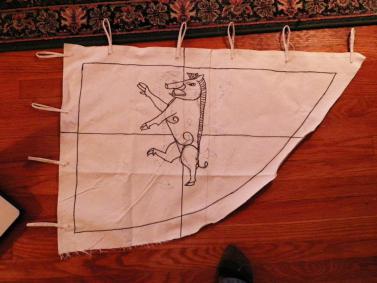 Cut fabric (preferably canvas) in desired size and shape. The fabric can be sewn at one of two points. The first point is here, prior to painting, where it may be easier to ensure the fabric is the right size and shape.The next step is to sketch out your design in pencil, and then when the sketch is complete, go over the lines with a permanent marker. Don’t try to erase your lines – you’ll get eraser gunk all over the canvas, which will cause issues when it comes time to put the base coat down.
Cut fabric (preferably canvas) in desired size and shape. The fabric can be sewn at one of two points. The first point is here, prior to painting, where it may be easier to ensure the fabric is the right size and shape.The next step is to sketch out your design in pencil, and then when the sketch is complete, go over the lines with a permanent marker. Don’t try to erase your lines – you’ll get eraser gunk all over the canvas, which will cause issues when it comes time to put the base coat down.
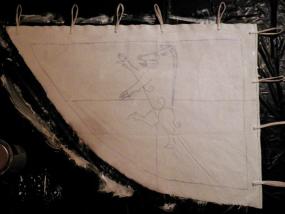 The next step is to take eggshell or matte exterior white latex paint (interior/exterior latex also works, but I usually use paint marked for exterior paint), and paint it over the surface you wish to paint with foam brushes, really making sure to work it into the canvas. This acts as a ground for the subsequent layers, and will make the colours you place over it brighter. This will also make the paint layers more durable. You will be able to see faint marker lines.
The next step is to take eggshell or matte exterior white latex paint (interior/exterior latex also works, but I usually use paint marked for exterior paint), and paint it over the surface you wish to paint with foam brushes, really making sure to work it into the canvas. This acts as a ground for the subsequent layers, and will make the colours you place over it brighter. This will also make the paint layers more durable. You will be able to see faint marker lines.
At this point, your canvas is a giant colouring book. Starting with your lightest colours and moving to your darkest, paint your heraldic design with regular craft acrylic paint (I used 95¢ craft paint).5 If you’re shading at this point, add those in at this point to better blend your colours. Mr Pig didn’t get a whole lot of shading, but on later projects, there’s a lot of shading and a lot of blending and a whole lot of diluting paint to make it blend better. It is acrylic paint, after all. Another word to the wise – painting two sides at once will make you crazy. Make sure all paint is dry before even thinking about painting the other side of a two-sided banner. Trust me. TRUST ME.
Once your paint has dried and you are completely done with painting, go over your charges with a permanent marker. This does one of two things: it makes the charge pop, and makes it easier to determine the charge from across a hall or a field.
At this point, you can also sew your banner into its finished shape, though it will be closer to sewing a light leather than the canvas by itself, which is why I prefer doing all of my sewing prior to painting.
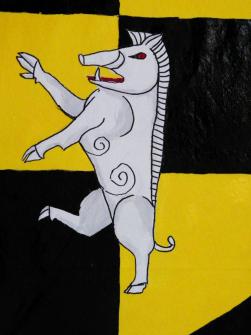 Lastly, you will need to spray your banner with clear spray paint. This further protects the design from the elements, and gives the fabric a nice sheen. It also gives the banner a more finished look.
Lastly, you will need to spray your banner with clear spray paint. This further protects the design from the elements, and gives the fabric a nice sheen. It also gives the banner a more finished look.
If you paint your banner, let me know how it turns out! I’d love to see what you’ve accomplished!
Osgar of Grimfells – Torse
Sabine of Carlsby – AoA
Rosie Haley – Queen’s Chalice
Hirakawa Kagetora – Leather Mallet
Melanie de la Tour – Golden Calon Swan
Other court news:
Jaida de Leon – new Kingdom Arts & Sciences Champion
Lillian Bowyer won the Judges’ Choice award
Paul Adler is the new Kingdom Minister of Arts & Sciences
6 people received Newcomer mugs
A boon was begged for Isengrim Sleggja to join the Order of the Laurel
Reposted with permission from https://kaloethina.wordpress.com.
Original post appeared October 19, 2014
About a week ago, I posted photos of my Rose in Any Medium goblet entry that I did with diamond point engraving. I also promised those in the Artisans of the Society for Creative Anachronism Facebook group that I would publish a tutorial on how to decorate glass with this technique.
Here’s what you will need:
 A glass object (most engraved pieces in period were either goblets or plates. I’ve had better luck with goblets, but your mileage may vary. I purchase most of my glass for these projects at thrift stores, but I’ve also had luck finding cheap Libbey-ware at the dollar store.)
A glass object (most engraved pieces in period were either goblets or plates. I’ve had better luck with goblets, but your mileage may vary. I purchase most of my glass for these projects at thrift stores, but I’ve also had luck finding cheap Libbey-ware at the dollar store.)
Permanent markers (I am fond of using multiple widths – I’ve got brush tips, fine tips, ultra-fine tips . . . they all work for this. Do not use china markers for this project. Repeat. Do not use china markers for this project. They will mess up your diamond tip. Don’t ask me how I know.)
Rubbing alcohol (you’ll see why later!)
 A diamond-point engraver (these can be purchased from Ted Pella as a “diamond scribe,” and it may be more inexpensive to go with an angled tip and with a pair of pliers, gently shape into a straight scribe. Originally made for the science industry, these are great for creating random bits of SCA pretty!)
A diamond-point engraver (these can be purchased from Ted Pella as a “diamond scribe,” and it may be more inexpensive to go with an angled tip and with a pair of pliers, gently shape into a straight scribe. Originally made for the science industry, these are great for creating random bits of SCA pretty!)
Paper or low-lint fabric towels (again, you’ll see why later)
Safety glasses (you will be making glass chips. Need I say more?)
Optional items
A plastic storage container, lined with soft material (mostly because I have found that this can be very taxing on hands, and well, glass is fragile)
A pencil grip (you are putting a lot of pressure on hands and fingers on a metal scribe, which fatigues the hands. Using a pencil grip to help cushion may help you out)
Sketched art of common motifs as found in period and tape (if you have difficulties drawing, but can trace, this can help you out a lot)
Process
Ready to get started? Excellent!
 Step one: Use the rubbing alcohol and paper towels to clean your glass of any oils, gack, or china marking pencils (like my local thrift stores are fond of using). You may also run your piece through the dishwasher, and then use the rubbing alcohol, but the key is to have a super-clean surface. The reasoning for having a super-clean surface is so the engraver can stay in contact with the glass as you sketch your drawing onto it. Also, take this time to inspect your piece. It should have no bubbles, cracks, etc. If it does, this can cause the piece to break while you’re working on it.
Step one: Use the rubbing alcohol and paper towels to clean your glass of any oils, gack, or china marking pencils (like my local thrift stores are fond of using). You may also run your piece through the dishwasher, and then use the rubbing alcohol, but the key is to have a super-clean surface. The reasoning for having a super-clean surface is so the engraver can stay in contact with the glass as you sketch your drawing onto it. Also, take this time to inspect your piece. It should have no bubbles, cracks, etc. If it does, this can cause the piece to break while you’re working on it.
Step two: Take your permanent markers, and start sketching your design on the surface. If you cannot
 draw, tape art of your motif on the inside of the glass, and trace with the marker on the outside. The downside of this method is that the design can become warped. When you do your layouts, remember that what you draw out will look frosted over, and while you can do hatching, it will look darker or different.
draw, tape art of your motif on the inside of the glass, and trace with the marker on the outside. The downside of this method is that the design can become warped. When you do your layouts, remember that what you draw out will look frosted over, and while you can do hatching, it will look darker or different.
 Do not worry if you make a mistake at this point. Use your rubbing alcohol to clean up any mistakes and keep going – at this point, you’re doing your layout, and details may change from this point forward. Also, do not worry if the ink comes off before you want – keep your permanent marker nearby and draw the detail back in.
Do not worry if you make a mistake at this point. Use your rubbing alcohol to clean up any mistakes and keep going – at this point, you’re doing your layout, and details may change from this point forward. Also, do not worry if the ink comes off before you want – keep your permanent marker nearby and draw the detail back in.
Step three: Put on your safety glasses, uncap your engraver, and start scratching away on your lines. Every engraver has a “side,” meaning that there
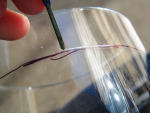 is a sharper side that will be easier to scratch with. Additionally, you will need to use some pressure, and this is truly the nerve-wracking part, as calibrating the proper amount of pressure takes practice. You’ll also want to be able to wipe away glass chips as you go, as these can accumulate on the glass itself. At this point, you’ll be scratching on the lines you’ve drawn on the outside. Work until you’re happy with it.
is a sharper side that will be easier to scratch with. Additionally, you will need to use some pressure, and this is truly the nerve-wracking part, as calibrating the proper amount of pressure takes practice. You’ll also want to be able to wipe away glass chips as you go, as these can accumulate on the glass itself. At this point, you’ll be scratching on the lines you’ve drawn on the outside. Work until you’re happy with it.
Tips
For straight lines going around the glass, you can place your engraver on a pile of books or magazines, press down on the engraver, and rotate the glass. However, depending on the thickness of your glass, this may or may not remove a well-formed ring of glass (which looks cool, yes, but shortens the glass and can create further issues, as the rim is now sharp).
Have spare glasses at the ready. Breakage doesn’t happen often, but it is a risk.
You must be logged in to post a comment.